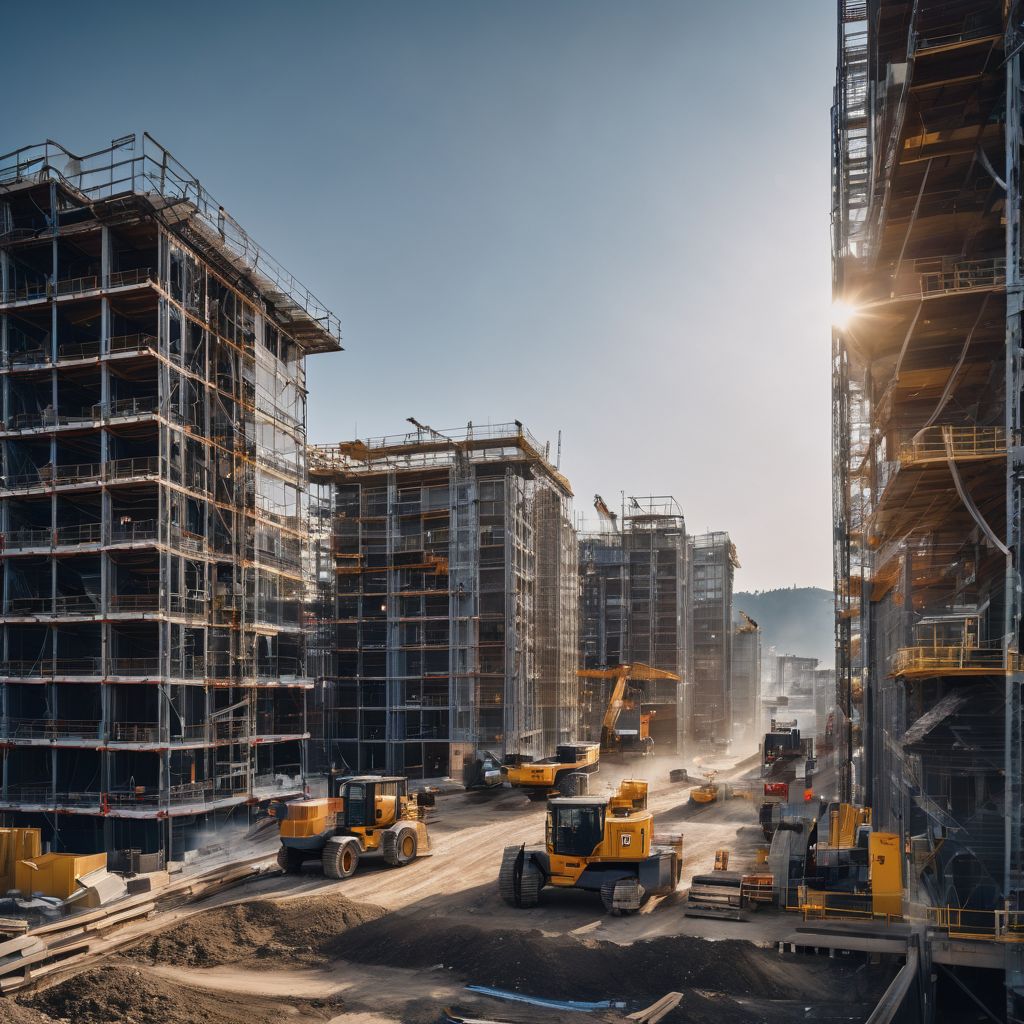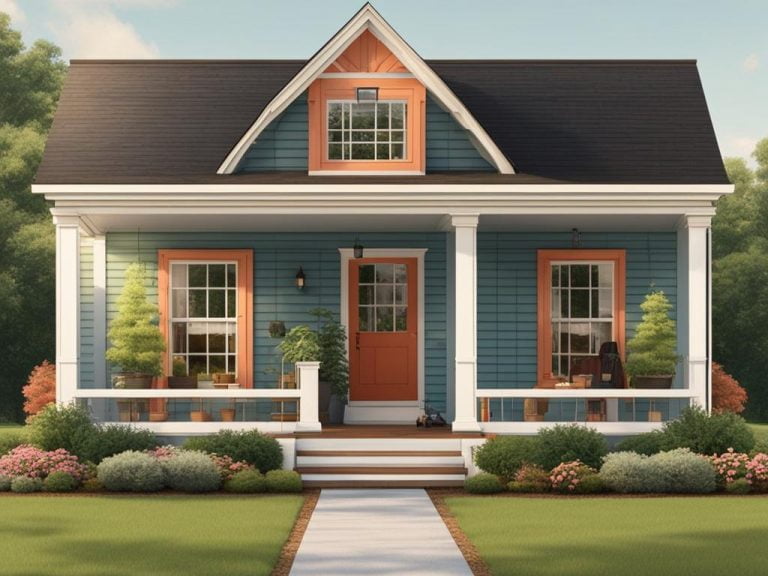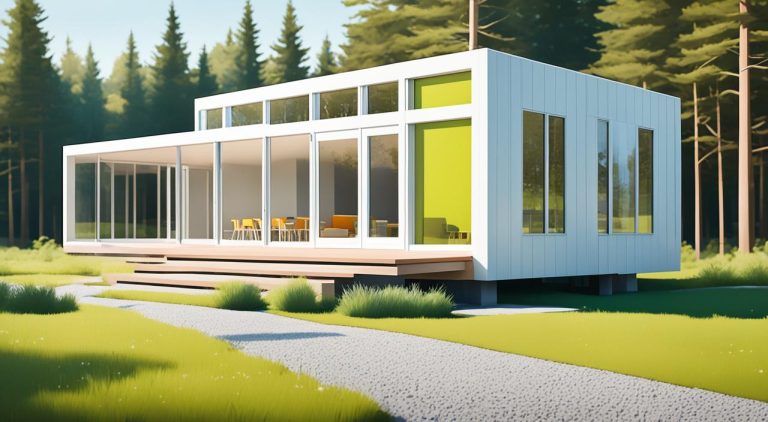China Prefab Manufacturers to Lead Modular Construction Industry?


In the bustling world of construction, time and efficiency are everything. China’s prefab manufacturers are making waves, with a projected industry growth stout enough to raise eyebrows—a CAGR of 5% by 2027.
This article will delve into how these manufacturers might just hammer their way to the top spot in modular construction globally. Ready for an illuminating read?.
Key Takeaways
- China’s prefab manufacturers are growing fast, aiming for a big 5% yearly increase by 2027. They’re winning contracts all around the world.
- Covid made things tough, but it also pushed for quicker building of things like hospitals and work-from-home spaces.
- The modular construction market in China is set to jump from $16.25 billion to a whopping $24.92 billion by 2030.
- Trouble’s brewing with money problems, tricky contracts, not enough tools or skilled workers, and sometimes designs just don’t hit the mark.
- Big companies like CIMC Modular Building Systems and Hangxiao Steel Structure are changing skylines with their smart building ways.
The Rise of China’s Prefab Manufacturers

The ascent of China’s prefab companies is quite the spectacle, almost as if they’ve masterminded a cunning plan to dominate the modular construction chessboard. With an eye on the international prize and a playbook teeming with fresh policies and scholarly musings—these manufacturers are not just building structures, they’re constructing a formidable narrative in global markets.
Securing International Contracts
China’s prefab manufacturers are not just busy at home; they’re blitzing the global market with a charm offensive. They’ve clinched deals far and wide, their hands shaken on every continent but Antarctica—penguins aren’t big on board meetings, after all.
These firms weave through international building codes like pros, tailoring modular marvels to diverse clients.
With contracts popping up in pockets from Asia to Africa—and whispers of ventures into Europe—it seems China is playing a proper game of Monopoly, but with actual buildings. And what’s their currency? Modular units that promise swifter construction times without skimping on quality—a proposition as tempting as biscuits with tea.
This is where speed meets scale and sets the bar high for rivals peeking over the Great Wall of prefab progress.
The Growing Body of Prefab Policy and Research in the Asia-Pacific Region
It seems like the whole Asia-Pacific is in on a secret – prefab’s the way forward. Singapore’s not shy about it; they’ve gone and made bits of prefab construction a must-do. Good move, really, since there are plenty of homes to build with around 939 million people needing roofs over their heads.
Prefab policies are sprouting up faster than bamboo shoots across the region.
Research into this nifty form of building houses and offices isn’t just gathering dust on shelves either. Experts reckon that with all those brains picking over prefab’s potential, we could see market growth hitting a perky 6% by 2028.
That’s no snail’s pace, especially when folks are eyeing up green infrastructure and economic zones as places to plant these modern marvels. It’s clear: prefab’s got its marching orders in Asia-Pacific and it’s ready to conquer lands far beyond China’s shores!
The Current State of the Modular Construction Market in China

In the Land of the Red Dragon, modular construction is far from a sleeping giant—rather, it’s wide awake and on its feet. With innovative strides propelling this market forward amidst global uncertainty, China’s prefab scene is a bustling hub where tradition meets modernity with an industrious clank.
The Impact of COVID-19
COVID-19 threw quite the spanner in the works, didn’t it? China’s prefab manufacturers felt the pinch as projects slowed down or paused. But let’s not get too gloomy – challenges often lead to innovation.
The industry is now standing by, report in hand, ready to dissect this pandemic puzzle.
The virus did more than just stir up a spot of bother; it sparked change across the modular construction market. Suddenly, there was a rush for buildings that could pop up faster than you can say “prefabricated”.
Healthcare needed emergency wards yesterday and residential spaces had to adapt to our newfound love for working in pyjamas. Change wasn’t coming—it galloped in on a virus-shaped horse!
Key Market Insights and Trends
Prefab building is on the rise in China, and it’s not just about putting up houses quickly. The market is growing fast, with a jump from $16.25 billion to an eye-widening $24.92 billion expected by 2030.
It seems more people want their buildings made like cars—fast and in comes the savings! Urbanisation is feeding this trend as cities swell with new folks needing places to live and work.
Trends are clear—the Chinese are leaning into modular methods like never before. They’re spotting the value of slapping together sections of buildings rather than hammering each nail on-site.
The construction sector has caught wind of the potential for green roofs and energy-saving designs that could very well help mitigate climate change issues. Now, let’s cast a glance at who’s making waves in China’s prefab industry, shall we?.
Major Restraints and Challenges
It’s not all cups of tea and biscuits for China’s prefab manufacturers; they’re facing a real pickle. Money troubles, messy contracts, and not enough kit or skilled workers make the list.
Oh, and let’s not forget designs that sometimes miss the mark – it happens even to the best of us! With 23 variables playing cat’s cradle with prefabrication promotion in China, one does wish for simpler times.
Consumer perceptions can play spoilsport too—folks aren’t always eager beavers about modular homes. Environmental worries nip at their heels while rising production costs loom like an unwanted guest.
It seems there’s quite the mountain to climb before reaching prefab peak performance in the land of dragons.
Key Players in the China Prefab Industry
Let’s take a peek at the movers and shakers shaping China’s prefab scene, shall we? From ingenious startups to seasoned heavyweights, these key players are redefining skylines with speed and finesse.
Profiles of Leading Companies
- CIMC Modular Building Systems shines as a titan in modular mischief. Known for their solid steel structured wizardry, they’re a force majeure in crafting colossal commercial marvels.
- Hangxiao Steel Structure steps onto the stage with flair, constructing dreams from the ground up. They juggle design, manufacturing and assembly with a finesse that keeps them at the vanguard.
- China Construction Integrated Construction has carved out its empire in efficiency. They turn chaos into order by spit-polishing projects to gleam with precision and practicality.
Noteworthy Industry Developments
- Secured mega deals abroad, especially in those markets that are rather keen on affordable housing options. These contracts showcase Chinese expertise and expand their reach in the global arena.
- Made significant strides in sustainable living practices. By focusing on green construction, they’re ensuring buildings aren’t just sprouting up quickly but also doing their bit for our dear old Earth.
- Introduced innovative construction materials to the fray. Think less traditional brick and more cutting-edge concrete composites that set quicker than your last New Year’s resolutions.
- Implemented advanced construction technology to speed up building times. It’s all about snapping together modules like a grand game of Lego, only these blocks weigh a tad more.
- Expanded into special economic zones (SEZs), making full use of preferential policies and incentives doled out like sweets at a bank holiday parade.
The Role of Prefab Manufacturing in the Future of Construction
Peering into the crystal ball of construction, one can hardly ignore the looming silhouette of prefab manufacturing. This visionary technique is set to revolutionise our approach to erecting edifices, promising sleeker skylines with a brisk efficiency that traditional methods can only gawk at in green-eyed envy.
Increased Adoption of Permanent and Relocatable Modular Buildings
More folks are choosing prefab buildings that stick around or can move to new spots. It’s like picking a sofa that doubles as a bed—quite handy, really. These modular wonders pop up faster than a batch of scones in the oven, slashing construction time by heaps.
The market for these clever constructions is swelling too, set to hit USD 28.8 billion by 2032 in China alone.
Builders love them because they can put them together come rain or shine, which in Blighty, means rather often. They’re used everywhere: shops, hospitals, schools—you name it. And let’s not forget how they cut down on mess and waste at the building site.
Quite tidy and green if you ask me—a bit like cricket played on an eco-friendly pitch!
Use of Different Materials: Concrete, Steel, and Wood
Oh, the trio of construction materials – concrete, steel, and wood – they’re a bit like the three musketeers of prefab building. Each one brings its own flair to the party. Concrete is sturdy and has a knack for keeping cool during those sizzling summer days.
Plus, it doesn’t get nibbled by termites or go up in flames easily – quite reassuring, wouldn’t you say?.
Now steel, that’s the strong silent type; tall structures fancy it for their backbone. It’s defying winds and shaking off earthquakes with a quiet confidence that says “I’ve got this.” And then we have wood—charming timber with its natural vibe making eco-friendly hearts flutter everywhere.
Light on its feet yet robust enough to keep your house from doing a little dance in rough weather.
Using these materials cleverly means prefab houses can pop up swiftly across different landscapes – think green buildings nestled in leafy settings or sleek urban designs cutting fine figures against city skylines.
Applications in Various Sectors: Commercial, Healthcare, Education & Institutional, Hospitality
China’s prefab manufacturers are not just playing with building blocks. They’re reshaping how we construct everything from offices to hospitals.
- In the commercial world, time is money, and prefabricated buildings save plenty of it. Offices and retail spaces spring up faster than you can say “market trends”. With designs that often include sleek glass facades and nifty modular workspaces, these constructions are as stylish as they are swift.
- Healthcare facilities benefit too. Hospitals can expand quicker than the flu during winter. Imagine adding an entire wing in months rather than years. It’s not just about speed either; it’s about precision. Prefab parts mean fewer on-site accidents, which is quite handy when you’re building…a hospital.
- Education institutions are making the grade with prefab constructions. Classrooms that once took a school year to build now pop up over summer break. These buildings aren’t just fast; they’re smart too – energy-efficient, sustainable, and quite capable of handling the occasional student-caused earthquake.
- For institutional structures like government buildings, prefab brings something special to the table: consistency. Each module is crafted under keen eyes in a factory setting, ensuring that every office measures up to the high standards bureaucrats adore.
- Hospitality gets a warm welcome from prefab construction as well. Hotels go from foundation to “First guest check-in” at bewildering speed. And because sections are built off-site, there’s less noise pollution—something both guests and neighbours appreciate after a long day.
Case Studies of Successful Modular Construction Projects
Dive into a series of modular marvels where China’s prefab prowess shines, from cutting-edge industrial complexes to chic container homes — a testament to the potential that lies in building smarter, not harder.
Prefabricated Industrial Factory Warehouse
Imagine a huge industrial warehouse, pieced together like an enormous jigsaw puzzle. That’s the reality of prefab wonders in China these days. They’re crafting immense factories with all parts made off-site.
It’s a bit like snapping together those plastic bricks as a child, but on steroids and for serious grown-up use. These warehouses pop up faster than mushrooms in damp British weather – rather impressive, isn’t it?.
Now picture steel girders joining hands elegantly to shape spacious interiors fit for giants or at least their machinery cousins. These are no ugly ducklings; they’ve got style and substance, not forgetting strength from their steel bones.
Tick-tock, the clock laughs as traditional construction sweats to keep up. And before you can say ‘Bob’s your uncle,’ onto our next modern marvel: Mobile Prefab Steel Container Building..
Mobile Prefab Steel Container Building
Mobile prefab steel container buildings are having a bit of a moment, aren’t they? They’re sturdy little chaps that come together quicker than your average flat-pack wardrobe. We’re not just talking about throwing up a makeshift shed, but crafting homes and offices that snap together with the elegance of Lego bricks on steroids.
Using light steel structures, these containers can save heaps of construction time.
These modular maestros make life look easy – optimising materials for longer service lives without breaking into a sweat. And let’s not forget how they gracefully dodge acoustic woes and shake off seismic shivers, thanks to their clever design studies.
Quite the performance indeed! It’s no wonder this approach is turning heads in the prefabricated house scene—practicality meets pizzazz, with a dash of British ingenuity for good measure.
Prefabricated Modular House Steel Structure
Prefabricated modular houses are taking the construction world by storm, with steel structures at the forefront of this quiet revolution. Imagine building a house like stacking Lego bricks; that’s the simplicity we’re talking about.
These houses come together much faster than traditional brick and mortar – rather brilliant when time is a cheeky little commodity that likes to run away from us.
Steel frames make these homes strong, and they stand tall against fire or weather’s nasty moods. They’re like a British bulldog—sturdy and reliable, but much better for living in.
With fewer chaps needed on site and less mess to clean up after, it’s easy to see why they’re becoming quite the talk of the town among those who fancy building without a fuss.
Conclusion
Well then, mates, it seems China’s prefab powerhouses are on the front foot. Their knack for crafting modular marvels could very well put them at the helm of construction’s future.
Challenges? Sure, they’ve got a few to hammer out. But with growth numbers like these and innovation in their toolkit, they’re set to build more than just buildings—they’re shaping an industry.
Keep an eye on this space; it’s bound to be a bobby-dazzler!
FAQs
1. Are China prefab manufacturers set to dominate the modular construction industry?
Yes, with a strong competitive landscape and market segmentation strategies, China’s prefabricated buildings industry is poised to lead in modular construction.
2. What makes Chinese prefab construction stand out?
Chinese government support, coupled with advancements in prefabricated construction techniques, positions them at the forefront of this sector within developing and Southeast Asian countries.
3. How does prefab manufacturing address environmental concerns?
China’s prefab manufacturers are focusing on ecological building practices that enhance water management, biodiversity conservation, and reduce urban heat islands – crucial in wetlands prone to flooding or drought.
4. Can this industry boost employment in China?
Absolutely! The growth of the Chinese economy through prefabricated construction promises increased job opportunities across various sectors including banking, home decor, and more.
5. Will choosing a prefab home from China impact my inbox or spam folder due to content delivery network issues?
No worries there – selecting a Chinese-made prefab home has no effect on your inbox or spam folder; those are related to email communications rather than physical product delivery networks.






